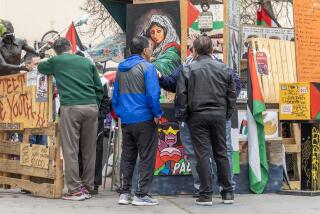World Diplomats Get a Workout at Rogers’ Workshop
- Share via
CORONADO — Carl Rogers’ person-centered approach to conflict resolution got a workout at the Vienna Peace Conference in a secluded, retreat-like setting in Rust, Austria. The first public briefing about the early-November, international event took place late last month at the Hotel del Coronado.
“This was a new experience for diplomats,” said Rogers, who, at 84, is actively seeking his dream of world peace. “It’s a fluid, crazy process. But it worked. We wanted a gathering where influential international figures could meet ‘off the record’ and talk, argue, shout and embrace in a situation where the staff makes it safe to do so, until they come to know each other deeply, to trust one another more fully, and work together for peaceful solutions.”
The conference was supported in concept by the Carnegie Foundation, U.S. Sen. Gary Hart (D-Colo.), Dr. Jonas Salk, Assistant Secretary General of the United Nations Robert Muller, Notre Dame University President Father Theodore Hesburgh, and others. It was co-sponsored by Carl Rogers’ Center for Studies of the Person (CSP) in La Jolla, and Rodrigo Carazo, former president of Costa Rica and founder of the United Nations-backed University for Peace.
At the workshop, participants from 17 countries met to focus on “The Central America Challenge.” Three former presidents of Latin American countries, members of parliaments, ambassadors, scholars and experts in foreign policy were among the 48 participants, who included activist actor Dennis Weaver and Assemblyman John Vasconcellos (D-San Jose). The delegations were from Central and South America, Europe, the Philippines, India and the United States.
Some participants were familiar with Rogers’ work, and others were drawn by the Central American theme. The workshop evolved with no set agenda, with protocol set aside. Free from the limelight, participants could meet as individuals. The strategy was to turn power over to the group.
“Our task was to create the environment,” said Gay Swenson, workshop co-director, “then to get out of the way as much as possible.”
Rogers and his staff were prepared for the unstructured nature of the early stages of the conference. “Out of seeming chaos comes order if you’ll permit it to come,” Rogers said. “It would have been easy to go there with American technology, to tie up the leadership. But we listened.”
“I said less, but worked harder than ever before in my life,” said one CSP staffer. Initial workshop meetings were polite but tense, crackling with heated dialogue and debate. Gradually, tangible peacemaking efforts began to evolve.
By midway through the four-day session, according to a CSP staffer, “Even the two major political protagonists had bent toward each other by inches. They were listening with a willingness to change.” By Day Four, the two were talking of their hopes and fears for their own children, and planning exchange visits between their families.
Austrian banker and project backer Karl Vak compared the first and last days of the conference: “I couldn’t believe how the community had changed. The first meeting was so full of tension. The final session was so fraternal.”
“What emerged was how often Central America felt unheard,” Swenson said. “When we make the Central American issue an East-West problem, it usurps the rights of the people to find their own solutions for their countries.”
Significant barriers to communication existed. Coordination of three different staffs (Austrian, American and Costa Rican) and the diversity of participants’ backgrounds and views presented a microcosm of world politics.
“We had to avoid thinking of each other in Machiavellian terms,” Swenson said.
Staff members often chose active silence, rather than strong leadership in small group sessions, relinquishing personal goals and agendas.
Another staff member, Brazilian-born Maria Villas-Boas Bowen, said, “For the first time in my life, I held back on personal issues in face of life-and-death issues. We found ourselves between cultures, caught in the drama of Central America.”
“I came away with a true sense of Central America as one of the world’s tragic, complex hot spots,” said Bob Livingston, a UC San Diego professor of neurosciences who attended the workshop. “I was impressed by the integrity of Rogers himself. People took him seriously. They could speak disarmed.”
Swedish delegate and Parliament member Brigitta Hambraeus intends to propose a similar workshop at a Stockholm conference as a trust-building device for other areas of crisis.
Not all attendees gave completely positive conference evaluations.
“I don’t want to idealize this,” Swenson said. “There were people who were not satisfied, who called the approach either haphazard or evangelical. But the purpose of the meeting was to stay conscious, keep learning.”
Rogers intends to monitor results of the Vienna Peace Conference and eventually establish a training center for diplomats and foreign service personnel.
More to Read
Sign up for Essential California
The most important California stories and recommendations in your inbox every morning.
You may occasionally receive promotional content from the Los Angeles Times.













